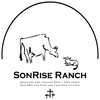Before we examine this subject we might want to look at a few pre-requisites for the use of any word or phrase; application, definition and context.
To begin with, here at SonRise we subscribe to the philosophy that overgrazing cannot be applied to an area, but rather a plant. My firm opinion is that we cannot look at a pasture, field or any other spatially defined area and determine that it is overgrazed. Only a plant can be overgrazed.
A good analogy for this would be if you were a factory supervisor with, lets say, 200 workers on the floor. You look out one day and describe your staff as overworked - is that true? What about Brad, manning machine #17 - he's is just smoking along, happy, productive and not a care in the world. He could quite easily take on another three or four tasks. But, then there is Lisa working on machine #39, she has three children and her husband is deployed overseas, serving in the military. She is mentally and physically exhausted - ask her to do another thing, and she might just kill you.
If you draw your factory work-load conclusions contingent upon an encounter with Lisa, you may define your factory as overworked. If you did so on a conversation with Brad, you would conclude the opposite. My point is this, you cannot drew a general conclusion from a specific sub-set with any accuracy.
Why?
Well, what if Brad's child dies tomorrow in an ice skating accident, as terrible as that sounds. And, on the same night, Lisa's husband unexpectedly comes home - bingo, now your entire evaluation is incorrect and the factory workload is the exact inverse of your previous conclusion.
The same is true when we evaluate our pastures and grazing impact. We need to take a holistic view of the plants present. Are they recovering sufficiently before the next grazing period? Do they seem stressed? Are there roots receding, or expanding (good luck trying to see this - alfalfa for example has a root system that spans up to 20') - I will circle back on this in a few, so hang tight.
Once we have agreed on the correct application of the word, we must define it. So lets see what the common definition is...
However, did you catch the application? "the failure of the rains led to overgrazing..."
What?
Rain has nothing to do with overgrazing of a plant, or plants. Rain has everything to do with erosion. The question is not "rain or no rain" the question is "effective rain" and for that we must turn to the problem of erosion. This is what we mean by context - you've got to use the word in the correct context for it to have meaning...
For a grass-fed beef operation to be efficient, it must, at it's core have an effective water-cycle (because the primary crop is grass not cattle). To do this we must control our animals. They work symbiotically with perennial grasses to cycle water and carbon.
Here is a quick (six-minuet) explanation of how we use our cattle and their symbiotic relationship with perennial grasses to fix imbalances in the ecosystem caused by previous, improper use of grazing animals (mostly cattle).
That's odd, huh?
You can actually use Cows to fix what Cows and Humans have done wrong... anyway, watch this, then think how it might be applied to your local context. Problems with fire? Inefficient water cycle? Brown rivers due to run-off from tilled and abused ground?
Cattle and perennial grasses are actually the answer - am I the only one who finds it astonishingly ironic that the misdirected, ill informed vegan world is demonizing cows when they are actually the solution?
It's not the "cow" - its the "how"
Stay tuned for part-2 when we look at how this pasture has recovered with the use of properly managed cattle.


 RSS Feed
RSS Feed